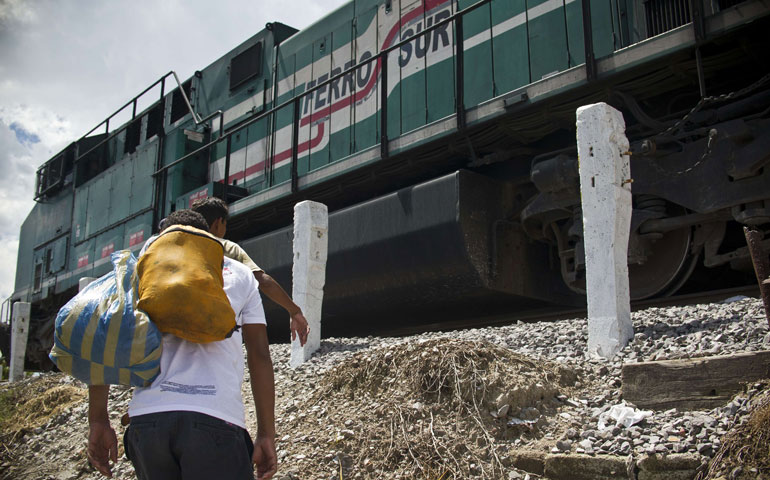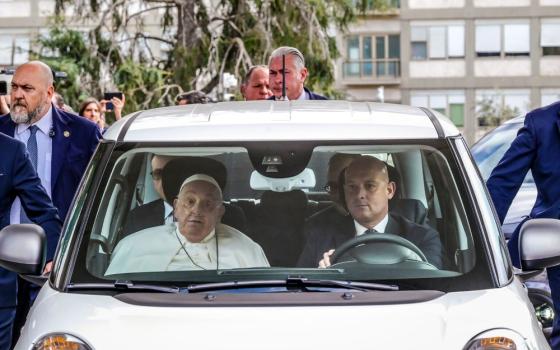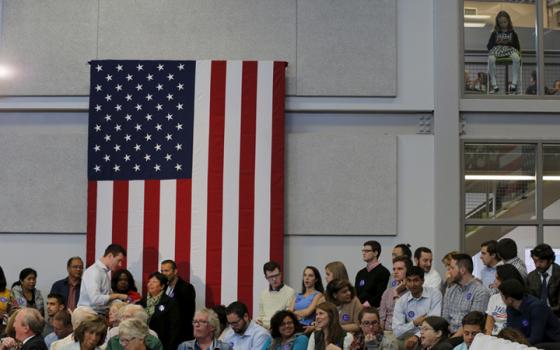
In Mexico July 22, a Central American migrant walks toward “La Bestia,” a cargo train headed for the U.S. border. (Newscom/AFP/Getty Images/Ronaldo Schemidt)
They set out -- alone, terrified and at the utter mercy of gangs and criminals -- on a treacherous journey for the promised land: a mass exodus of children, some as young as 4.
Most are fleeing their homes in Honduras, Guatemala and El Salvador, and it is un milagro, a miracle, if they ever arrive at the U.S. border.
The migrant trails through Mexico are torturous and fraught with dangers. Most children must not only endure the blazing desert sun, but get through La Arrocera, a lawless region where many have been beaten, robbed or raped. More than a few are murdered.
They are often shaken down by corrupt Mexican police and immigration officers who threaten to deport them unless they pay a bribe. Some are kidnapped and held in groups until relatives pay a ransom.
But if their luck holds -- if they escape serious injury and have not been deported or abducted -- they might catch a ride on the roof of a freight train that could bring them near the U.S. border.
But the train, known as "La Bestia," has its own deadly perils, as it passes through areas controlled by drug cartels. Children have fallen off or been thrown off the roof if they couldn't pay criminals who prey on the easy targets.
If they do make it to the border, they face swimming the Rio Grande. If their families have paid a coyote to get them across the border, their smuggler is likely to also be a drug trafficker. Criminals control the crossings, which are usually the same paths that drug mules use to cross the river.
If they don't drown, they arrive strangers in a strange land. More than a few of the girls are pregnant from rape. After a 1,500-mile trek through a modern-day heart of darkness, they are greeted with hostility by U.S. Border Patrol agents. More than 60,000 children have been arrested so far this year, many of whom are warehoused in detention centers, where they often languish in a legal limbo.
And yet they keep coming.
A desperate choice
Michelle Brané, director of the Migrant Rights and Justice Program at the Women's Refugee Commission, has offered an explanation: "While some children may be seeking to reunite with their parents or family in the United States, the motivating factor forcing them from their homes is violence and persecution. The children we spoke with told us they feared they would die if they stayed in their home country, and although they might die during the journey, at least they would have a chance."
The latest United Nations homicide figures show that these children are fleeing the most violent countries in the world: Honduras, El Salvador and Guatemala are three of the top five murder capitals of the world.
Desperate families face a desperate choice: Do they risk having their children remain in their home country, where they have witnessed unthinkable violence and criminal gangs attack or forcibly recruit them? Or do they hand their children and a year's wages over to smugglers who claim they can get them into los Estados Unidos?
The United Nations has urged the U.S. to treat the children from these three countries as refugees displaced by armed conflict, but politics being what they are, the White House and Congress are engaged in partisan battles and remain deadlocked over both short- and long-term solutions.
President Barack Obama has deported more than 2 million immigrants, a rate greater than that of any other president in history, but Attorney General Eric Holder has defended his record, saying, "The president has been unfairly labeled the deporter-in-chief."
The National Lawyers Guild has criticized the administration for expediting the deportations of children "fleeing persecution and violence in Central America," and for continuing to jail "thousands of women and children in hastily erected family detention centers, despite reports of abuse."
It's "a wholly inadequate response" and "ignores the root causes of this forced migration," the guild said, calling on the administration to adhere to its international human rights obligations and provide legal counsel to the children.
To stem the flow from Honduras, the country with the largest number of migrant children, the Obama administration has proposed a plan to consider giving them refugee status once they are screened in their own country.
Meanwhile, House Republicans passed two measures before the summer recess that would speed up deporting children, legislation that a Catholic bishop called "a low point for our country," and The Wall Street Journal blasted in an editorial. The newspaper took Republicans on for instigating "a screaming match on the floor in full view of the national media" and portraying itself as a "party whose preoccupation is deporting children," something certain "to alienate many conservatives, never mind minority voters."
Not about economics
Many Americans wrongly assume that most of these children are economic migrants. Some children no doubt want to escape extreme poverty. About 30 percent of Hondurans, according to the World Bank, live on less than $2 a day. And so-called free trade agreements like CAFTA, which protect corporations and promote sweatshops, have made the poor in these countries even poorer.
But poverty can't explain the current crisis. Neighboring Nicaragua -- the poorest country in Central America -- has very few child migrants.
A May 27 Border Patrol report states that while Guatemalan children from rural areas might be seeking economic opportunities, those from Honduras and El Salvador "come from extremely violent regions where they probably perceive the risk of traveling alone to the U.S. preferable to remaining at home."
Of the top 10 cities children are fleeing, seven are in Honduras, the report shows, with San Pedro Sula being No. 1.
What has been largely missing from the public debate is the elephant in the room: the full extent to which past and current U.S. policies have fostered the dire and violent conditions in these three countries, especially the U.S. training and funding of Latin American militaries.
Add to that the insatiable U.S. demand for illegal drugs and a U.S.-led drug war that has miserably failed, judging from the thriving drug cartels, the ready availability of drugs, the increase in migrants and the exploding homicide rates.
The most salient piece absent from debate on the Honduran refugee crisis is the Obama administration's failure to act in 2009 after the Honduran military overthrew the democratically elected president, Manuel Zelaya.
The coup was led by Gen. Romeo Orlando Vásquez Velásquez, who twice received training at the U.S. Army's School of the Americas, now known as the Western Hemisphere Institute for Security Cooperation (WHINSEC). The institution in Fort Benning, Ga., has trained so many coup leaders it was nicknamed the "School of Coups." Two other Honduran SOA-trained gen-erals -- Juan Melgar Castro and Policarpo Paz García -- overthrew earlier governments.
In 2009, not only did then-Secretary of State Hillary Clinton resist international pressure to reinstate Zelaya, but the administration allowed the training of Honduran officers to continue at the Fort Benning school despite its claims that it had cut military ties to the nation and despite federal law requiring that U.S. military aid and training be suspended when a country undergoes a military coup.
The blowback was almost immediate, as the U.S. disregard for the rule of law wasn't lost on the coup leaders.
Right after deposing the president, according to a 2014 Human Rights Watch report, "the de facto government suspended key civil liberties, including freedom of the press and assembly. In the ensuing days, security forces responded to generally peaceful demonstrations with excessive force and shut down opposition media outlets, which caused several deaths, scores of injuries, and thousands of arbitrary detentions."
In 2011, the Honduran Congress enacted a "decree allowing military personnel to carry out public security duties," the report said. In 2013, it passed another law creating "a military police force with powers to seize control of violent neighborhoods and carry out arrests, among other duties, despite a history of abuse by the military against civilians."
The bloodshed has gone unabated, with government and private security forces killing people alongside the drug cartels and gangs. A common perception is that gangs and drug cartels cause most of the violence, but human rights advocates say that these elements can't flourish without the complicity of the police and the military.
The country's murder rate spiked after the coup, going from 61.3 murders per 100,000 in 2008 to a whopping 90.4 in 2012, according to the latest U.N. figures, making Honduras the murder capital of the world. El Salvador ranks fourth with 41.2 and Guatemala fifth with 39.9.
The Human Rights Watch report concludes that the country "suffers from rampant crime and impunity for human rights abuses. ... Perpetrators of killings and other violent crimes are rarely brought to justice."
Yet, despite the repression and corruption, the U.S. has poured tens of millions of dollars into the country since the coup. And SOA/WHINSEC is still training Honduran officers, although it's impossible to assess the impact of the ongoing training. That's because the school has refused to release the names of its graduates ever since it was found in 2003 to have admitted human rights abusers like Salvadoran Col. Francisco del Cid -- who had been cited by the 1993 U.N. Truth Commission for commanding a unit that dragged people from their homes and shot them at point blank range.
Children as collateral damage
The Obama administration's inaction and disregard for the rule of law made Honduran children collateral damage from U.S. policies.
It also reinforced a bitter lesson Hondurans learned in the 1980s, when the Reagan administration pressured its leaders into joining the U.S. war against Nicaragua -- a war condemned by the International Court of Justice for "unlawful use of force."
Washington had assembled a Contra army, comprised largely of Somoza's former National Guard and led by officers the dictator had sent through the School of the Americas, then based in Panama.
These graduates included Ricardo "Chino" Lau, the counterintelligence chief implicated in the murder of Salvadoran Archbishop Oscar Romero; José Benito Bravo Centeno, a Contra commando trainer who murdered POWs; and Armando López, whom another Contra called a bloodthirsty serial killer.
The U.S. pressured Honduran President Roberto Suazo to make Gen. Gustavo Alvarez Martínez, a 1978 SOA graduate, the head of the Honduran armed forces, a favor he returned by aiding and abetting the Contra operation.
Alvarez created Battalion 3-16, a CIA- and SOA-trained Honduran military unit that The Baltimore Sun exposed as a death squad, with former members admitting the people they interrogated were stripped, then shocked by electrical wires clipped to their genitals, often with rubber masks wrapped tightly around their faces to cut off their air supply. Women were routinely raped.
And yet Alvarez was awarded the Legion of Merit by the Reagan administration for encouraging "democratic processes."
Hondurans not only saw the U.S. honoring a death squad creator, but illegally selling missiles to Iran to finance the Contra war after Congress cut off funding.
The Reagan administration's point man in the Iran-Contra scandal was ex-Marine Lt. Col. Oliver North, who also tried to recruit Panamanian Gen. Manuel Noriega, a five-time graduate of SOA, to destroy a Nicaraguan airport and an oil refinery.
What's more, secret manuals were produced during the Reagan administration for the Honduran military, the Contras and the SOA, whose manual advocated torture and assassination and were passed out by U.S. mobile training teams.
No one was ever disciplined for producing or using the materials, another clear message to the militaries of Honduras and other Central American countries that anything goes.
Today, Honduran government death squads are using tactics similar to those used by the death squads of the 1980s: arriving in the middle of the night, masked and in dark unmarked vehicles, to assassinate their victims. A warehouse security camera caught a death squad in action in 2013, executing two students in the back of the head as they lay face-down in the street.
In December 2013, the chief of Honduras' National Police, Gen. Juan Carlos Bonilla, an SOA graduate known as "el Tigre," was fired after he was linked to a death squad.
"A death squad government may not be the Obama administration's first choice for Honduras," Mark Weisbrot, co-director of the Center for Economic and Policy Research, wrote in The Guardian, "but they prefer it to another left government that people might elect if they were able to organize in a free election."
Even a 2013 U.S. State Department report admitted that there continues to be "widespread impunity" and "unlawful and arbitrary killings by security forces, organized criminal elements, and others." It also noted that seven journalists were killed and violent deaths of women increased by 246 percent in recent years.
This spring, Honduran President Juan Orlando Hernández sponsored a controversial military program called "Guardians of the Fatherland" to indoctrinate children as young as 5.
It was criticized as a path to militarization by José Guadalupe Ruelas, director of the children's shelter Casa Alianza. In May, Honduran military police arrested, beat and dragged him face-down by his feet, according to Amnesty International and the Committee of Relatives of the Detained and Disappeared in Honduras.
Ruelas had also issued a report detailing "an emerging pattern of organized people with access to expensive vehicles, weapons and equipment, who kidnap, torture and kill poor children and youths, in almost total impunity."
The bottom line is that the immigration crisis will never be solved as long as the U.S. funds repressive governments and trains their militaries under the pretext of the drug war, said Arturo Viscarra, an immigration lawyer who fled his Salvadoran homeland as a child and serves as the advocacy coordinator for the human rights organization SOA Watch.
"The U.S. has enormous power over Central America and an obligation to fix what it's broken," he said.
"When warning George Bush about invading Iraq, Colin Powell cited the Pottery Barn rule that if you break it, you own it." The same applies to Honduras, Viscarra said -- and Guatemala and El Salvador.
[Linda Cooper and James Hodge are the authors of Disturbing the Peace: The Story of Father Roy Bourgeois and the Movement to Close the School of Americas.]



